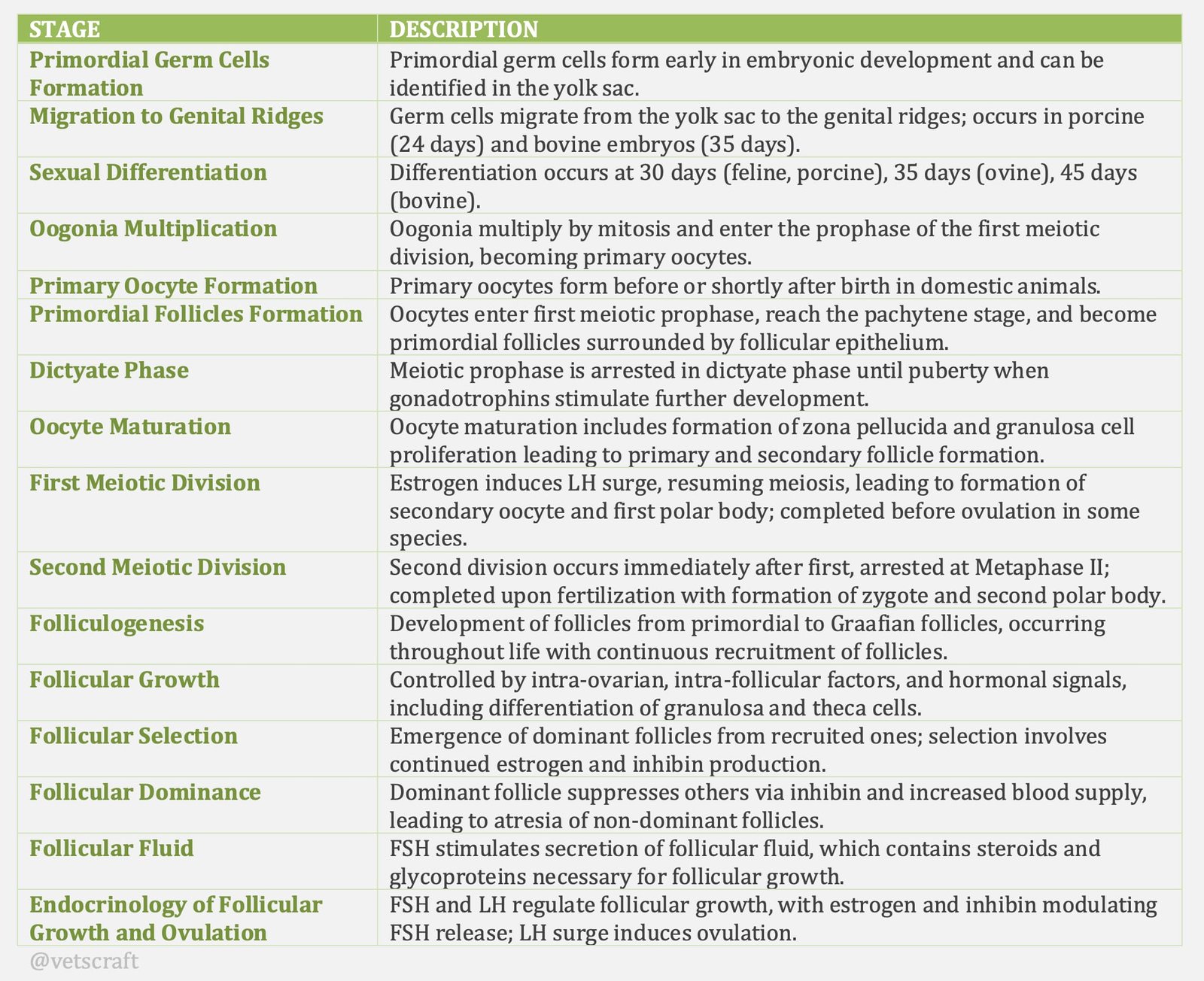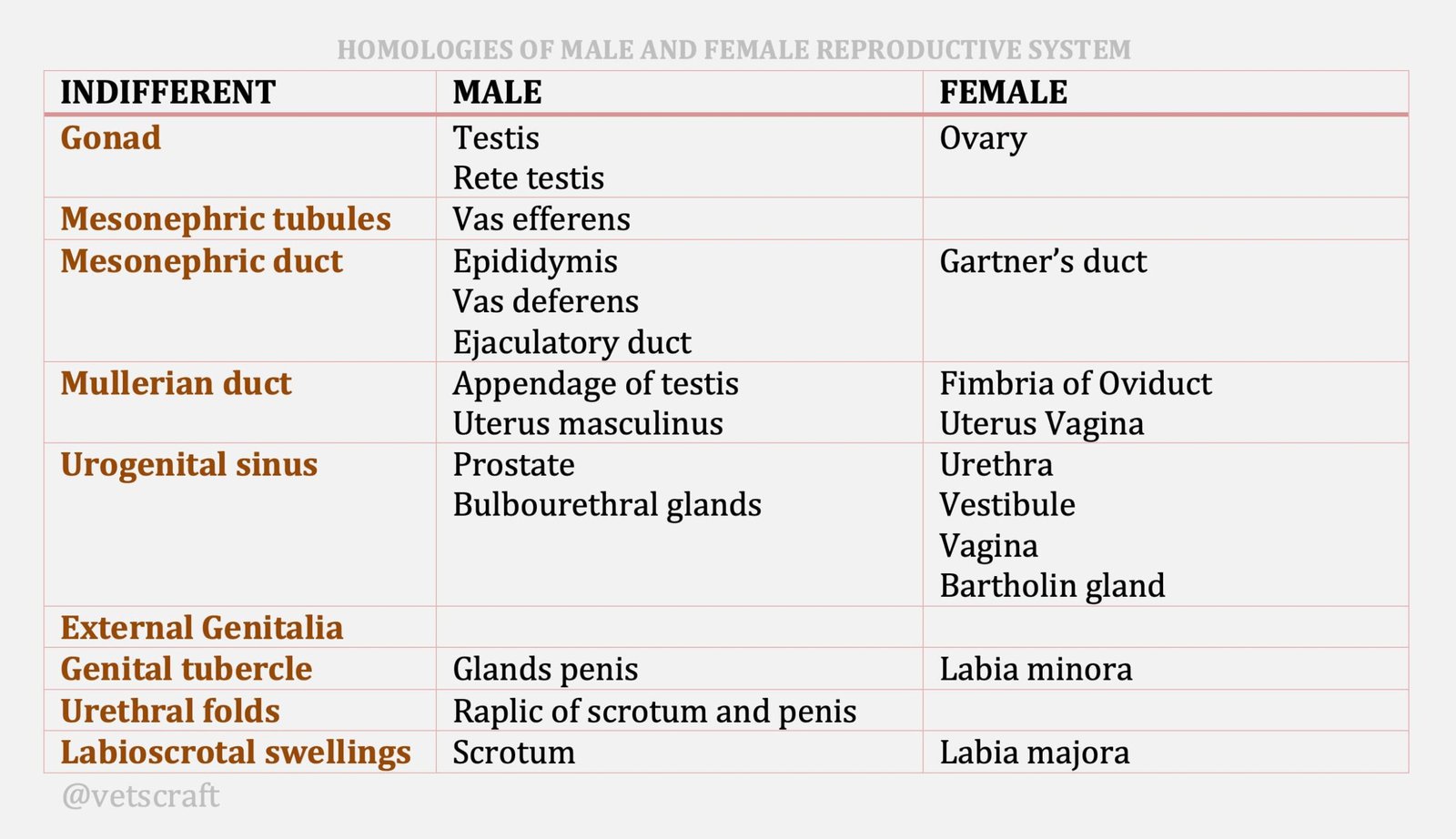TABLE OF CONTENTS
Ovogenesis or Oogenesis in Animals
Ovogenesis, also known as oogenesis, is the biological process through which female gametes, or ova, are formed in animals.
The ovary besides secreting the gonadal hormones produces the ova. Early in the first week of embryonic development the primitive large germ cells called as primordial germ cells can be identified in the yolk sac.

These germ cells migrate by amoeboid development from the yolk sac across the dorsal mesentery to the genital ridges. Migration occurs in porcine and bovine embryos by about 24 and 35 days of gestation.
In a few more days the gonadal sac can be distinguished by the formation of the superficial tunica albuginia and central location of spermatogonia in the primitive testes and the peripheral location of the oogonia in the primitive ovary.
Sexual differentiation occurs at 30 days of gestation in feline and porcine embryos and 35 days in ovines and 45 days in bovine embryos.
After differentiation these oogonia multiply by mitosis and enter the prophase of first meiotic division, when they are called primary oocytes. Oogenesis is completed before or shortly after birth in all domestic animals.
At the end of the period of Oogenesis, the oocytes enter the first meiotic prophase where they pass through leptotene and zygotene stage into the pachytene stage. At this stage the ova are surrounded by a single layer of follicular epithelium and are called primordial follicles.
The meiotic prophase is then arrested and the nucleus of the oocyte becomes dormant and will remain so until stimulated by gonadotrophins after puberty. This nuclear arrest condition is referred to as the dichyate (dictyotene) phase of meiotic prophase. Oocytes remain in this period of dictyotene arrest until ovulation occurs. The purpose of the nuclear arrest is to inactivate the DNA in the female gamete so that it is not vulnerable to possible insult during the lifetime of the gamete.
Insults or damage to DNA of the female gamete could compromise reproduction because embryo death would likely occur after fertilization.
During the late dietyate stage as ovulation approaches, the maturation of oocyte occurs with the formation of a gel like outer membrane, the Zona pellucid. Growth of oocyte is followed by growth of associated follicle FSH stimulates proliferation of granulose cells surrounding the oocyte. Primary follicle becomes secondary follicle. Continued stimulation results in formation of antrum. During this development the follicle destined to ovulate becomes dominant.
Estrogen reaches threshold levels leading to LH surge, which causes resumption of meiosis, extrusion of first polar body and formation of secondary oocyte. With this division the chromosome number in the oocyte is changed from 2N diploid to haploid 1N state. The secondary oocyte retains all the cytoplasm and half the nuclear material of the primary oocyte. The other half of the nuclear material is extruded as first polar body. This first meiotic division is completed shortly before ovulation in the cow, sow and ewe after ovulation in mare and bitches.
The second meiotic division occurs immediately after completion of first division. This division is arrested at Metaphase H. The second meiotic arrest is released during fertilization process. Meiotic H is initiated again and results in formation of zygote and extrusion of second polar body.
Folliculogenesis
Folliculogenesis involves in the growth and differentiation of vesicular follicle destined for ovulation. It includes development of primordial follicle to Graafian follicle.
In the primary follicle reserve, formed during fetal life or soon after birth (some primordial follicle begin to grow continuously throughout the life) when any follicle is released from this reserve, it continues to grow until ovulation or until the follicle degenerates, which is the case with majority of the follicle.
Ovarian follicular development in cows and ewes is a progressive and recurring process with two or three waves of follicular growth occurring in each cycle. In cows two waves appear to be more common but three waves are frequent in long cycles.
Follicle Growth
Follicular growth and maturation involves a series of sub cellular and molecular transformations of the follicular components like oocyte, granulosa and theca.
Follicular growth is controlled by:
- Several intra ovarian factors
- Intrafollicular factors
- Hormonal signals
Follicular growth involves-hormonally induced proliferation and differentiation of both theca and granulosa cells leading to produce oestradiol and to respond to gonadrotropins. Disturbances in the responsiveness of the granulosa and theca to the gonadotropins signals leads to cessation of follicular growth and initiation of atresia. Production of estradiol determines which follicle will gain the LH receptors necessary for ovulation and lutenization. From which one is selected to continues its growth, while others undergo atresia. When the selected follicle becomes larger in diameter as compared to other follicles in the same wave it is referred to as the dominant follicle.
Thus even though the follicular phase comprises only about 20% of the estrous cycle, the process of follicular growth and degeneration known as follicular dynamics occurs continuously throughout the entire oestrous cycles. If the ovaries are examined at any point during the estrous cycle significant number of antral follicles of various sizes will be seen. These antral follicles have been classified as small, medium and large depending on their diameter.
Example: In sheep and cow all healthy follicle 2mm in size are recruited and once selection has occurred recruitment is blocked. In sow, the recruitment of the ovulatory follicle in to the ovulatory population continues during the follicular phase.
Dynamics of antral follicles consists of:
- Recruitment
- Selection
- Dominance
- Atresia
Recruitment is a phase of follicular development in which is a group of small antral follicles begin to grow and produce estradiol. Some of these recruited follicles undergo atresis. Following recruitment, groups of growing follicles, which have not undergone atresia, are selected.
Selection involves the emergence of dominant follicles from the host of previously recruited antral follicles. Selected follicles may become dominant or they may undergo atresia.
As the selected follicle proceeds towards dominance, they continue to produce increasing amounts of estrogen as well as inhibin. In the cows and mare (monotocus sp) they are several selected follicles but only one will develop into the dominant follicle. Because of increasing inhibin levels and reduced blood supply to other follicles the dominant follicle causes inhibition of other follicles. Suppressed FSH concentration in blood along with reduced blood supply results in atresia. Only those follicles receiving a large blood supply and thus higher levels of gonadotrophin continue to grow.
The follicular dominance can be divided in the two components:
- Morphological dominance which rotates to the larger size of the selected follicle.
- Functional dominance: which is that the selected follicle actively inhibits the growth of the other follicles.
Follicular Fluid
FSH acts on the granulosa cells of the secondary follicles and causes secretion of follicular fluid. It originates mainly from peripheral plasma by transudation across the follicle basement lamina. It modified by follicular metabolic activities contains steroids and glycoproteins synthesised by the cells of the follicle wall. The large antrum follicular fluid contains high level of oestradiol 17 beta in the follicular phase.
Endocrinology of Follicular Growth and Ovulation
FSH plays a major role in antrum formation. This gonadotrophin stimulates granulose cell mitosis and follicular fluid formation. FSH also increases the sensitivity of granulose cells to LH by increasing LH receptors, which prepares for ovulation. On the other hand theca cells are stimulated only by LH and LH receptors are present from the beginning of theca cell formation.
During recruitment FSH and LH begin to increase, thus promoting follicle development. As follicles enter the selection phase, inhibin is produced by the follicles and inhibits FSH released by the anterior pituitary. As follicular dominance phase is entered, the large follicle produces more and more estrogen and thus causes the preovulatory surge center to release LH surge. In addition FSH concentration are reduced because of inhibin. This causes antral follicles to undergo atresia. FSH and LH are also essential for steriodogenesis (two cell two hormone theory).

